Accelerating Particles Accelerates Science — With Big Benefits for Society
Tackling the most challenging problems in accelerator science attracts the world's best and brightest to Brookhaven Lab. It's only natural that ideas and techniques born here take root in new research facilities around the world — and spark a host of spin-off applications for industry, medicine, national security, and more.
March 13, 2013
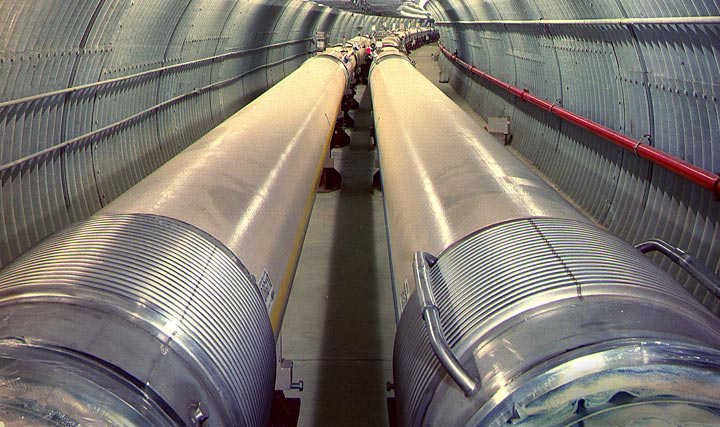 enlarge
enlarge
Twin accelerators: RHIC is really two accelerators in one — made of crisscrossing rings of superconducting magnets, enclosed in a tunnel 2.4 miles in circumference. In the two rings, beams of heavy ions are accelerated to nearly the speed of light in opposite directions, held in their orbits by powerful magnetic fields.
Some would call the Relativistic Heavy Ion Collider (RHIC) — an "atom smasher" at the U.S. Department of Energy's Brookhaven National Laboratory — the most modern accelerator facility in the world. Many ideas about how to accelerate, focus and collide beams of particles that were tried unsuccessfully elsewhere have succeeded at RHIC. And as scientists' understanding of the early-universe matter created in RHIC's light-speed collisions has evolved, so too has the collider itself —to probe ever deeper into the mysteries of how this primordial matter gave rise to the visible structure of the universe today.
The machine, which steers beams of billions of ions into collisions thousands of times per second, is operating at 15 times the level of performance for which it was designed.
"The versatility, performance, and improvements to this machine have been nothing short of astounding," said Thomas Roser, who heads the Collider-Accelerator Department at Brookhaven Lab.
For example, RHIC physicists have increased collision rates, or luminosity, with innovative techniques that squeeze, "cool," and nudge the beams to keep the ions within tightly packed, maximizing the chance these tiny particles will make contact when the beams cross.
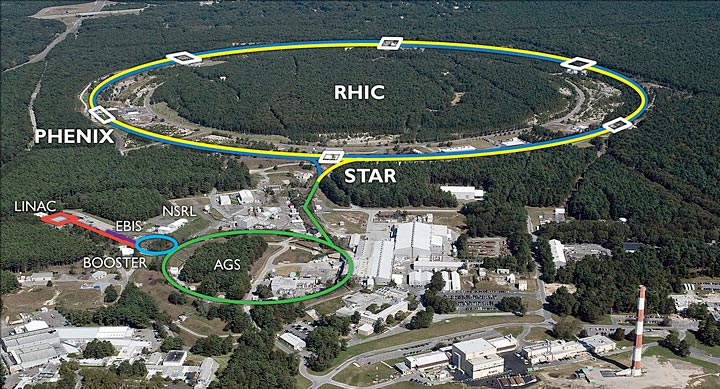 enlarge
enlarge
The RHIC accelerator complex: The particle smashups recreating early universe conditions at RHIC depend on a chain of accelerators to bring ions up to speed. Several links in the chain have interesting histories and applications beyond physics.
Each head-on, heavy-ion smashup momentarily "melts" the ions' inner components, protons and neutrons, to form a seething soup of quarks and gluons — the most fundamental building blocks of visible matter, which haven't existed in free form since just after the Big Bang. Understanding the strong force that holds these building blocks together and locks them within atomic nuclei today is one of the main scientific goals of RHIC.
Unlike any other collider in the world, RHIC can collide a variety of ions — from single protons to uranium nuclei, one of the heaviest naturally occurring atoms — at a very wide range of energies. This versatility allows physicists to explore the mysterious world of quark interactions and the strange and unexpected features of the strong force — including details of the transition from ordinary matter to what the universe looked like some 13.7 billion years ago.
For a separate research objective, RHIC is the only facility in the world that can accelerate and collide protons with their "spins" aligned. Collisions with such spin control allow physicists to tease out how quarks and gluons contribute to this intrinsic particle property used every day in medical imaging but with many mysteries remaining. RHIC is the first facility to reveal that gluons play a significant role.
Tackling challenges ignites interest
The success of RHIC is particularly impressive given that, at the beginning, scientists weren't sure it would work.
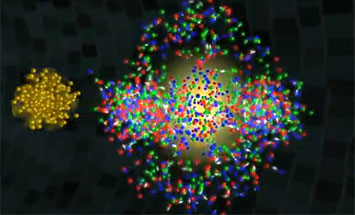
Gold ions colliding at nearly the speed of light at RHIC produce a "perfect" liquid quark-gluon plasma, offering insight into how matter behaved in the very early universe.
"Never before was a collider made to collide heavy ions," said Thomas Hemmick, a physicist at Stony Brook University and a collaborator on RHIC research. "There were many new challenges that were absolutely enormous."
Gold ions — the nuclei of gold atoms stripped of their electrons — carry enormous positive charge. As these highly charged particles pass closely by one another at high speed, they generate an extremely strong electromagnetic field, resulting in the production of many electrons and their oppositely charged counterparts, positrons. You can imagine that the negatively charged electrons would be very attracted to the positively charged gold ions. But capturing even one of these electrons would throw off the gold ion's total charge and allow it to escape from the beam.
"The probability of this loss process was not known before RHIC started, but calculations showed that it could be big enough to prevent survival of the beams," Hemmick said.
Furthermore, the high charge of the ion beams exerts significant forces on the electrons in the atoms that make up the beampipe walls, generating currents that heat the material. There was a chance that this heat would dissipate outward to warm up the surrounding superconducting magnets, which could quench, or "kill," their superconductivity, bringing the accelerator to a halt.
These challenges, said Hemmick, made Brookhaven itself a magnet — for accelerator physicists.
"Brookhaven is a site of particular excellence in terms of accelerator science," he said, "because the best people go to the greatest challenges."
Throughout the design and construction of RHIC in the 1980s and 1990s, nuclear and accelerator physicists — and students from all over the world — wanted to work on the project. Stony Brook, the university closest to Brookhaven, was a natural partner.
"Many successful students were coming to Stony Brook, some didn't even know accelerator physics was an option," Hemmick said, "but collaborations started to happen naturally because of the proximity of the Lab and the expertise of its physicists."
Now Hemmick is helping to foster a climate that nurtures those attracted to the scientific and technological challenges presented by RHIC and accelerator science in general. Together with Brookhaven physicist Vladimir Litvinenko, Hemmick co-directs the Center for Accelerator Science and Education (CASE), a unique joint university-laboratory graduate and post-graduate program focused on developing the next crop of accelerator scientists and engineers.
There's certainly a need — and not just for research.
Training a workforce for accelerator applications
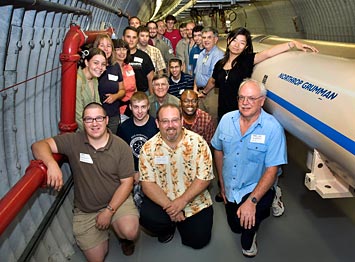 enlarge
enlarge
The Center for Accelerator Science and Education (CASE) helps to build America's future high-tech workforce. Here high-school students and teachers participating in a CASE workshop visit the RHIC accelerator tunnel.
Whether you know it or not, accelerators play a role in many aspects of our lives. The U.S. Department of Energy—whose Office of Science funds the research at RHIC—estimates that there are 30,000 accelerators operating in world. Many of these are small and conduct behind-the-scenes work: producing beams of radiation used to sterilize medical equipment and keep pathogens at bay in our food supply, imprinting computer chips with ions to improve their performance, producing radioisotopes for cancer diagnosis and treatment, and scanning shipping containers for illicit materials.
A recent report, 'Accelerators for America's Future,' describes many of these contributions and more, and the promise of next-generation particle beams:
"Other nations are already applying next-generation accelerator technologies to current-generation issues — and challenging United States leadership in accelerator innovation. To remain competitive will require a sustained and focused national effort…"
— and a well-trained, inspired workforce.
That's where large research centers like RHIC and educational efforts like CASE come in, Hemmick said, by preparing students who go on to work on next-generation technologies for many of these applications.
Physicists trained or working at RHIC also make direct contributions to these societal applications of accelerator science, even while still engaged in building and running the tools of basic physics research.
Medical advances
For example, Brookhaven is one of just two facilities in the U.S. that produces high-demand, short-supply radioactive isotopes used in heart-disease diagnosis, and Brookhaven scientists are actively exploring new applications in cancer diagnosis and treatment. The Brookhaven Linac Isotope Producer (BLIP) produces these isotopes by bombarding specific materials with protons that are accelerated through the 200-million-electron-volt (MeV) linear accelerator, or "linac," portion of the RHIC accelerator complex, piggybacking on ongoing RHIC operations funding. "Without RHIC, the production of these isotopes might become prohibitively expensive," Roser said.
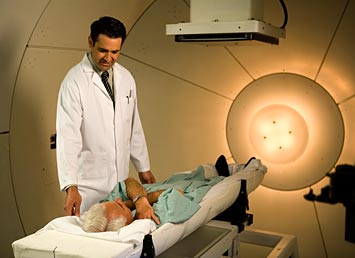 enlarge
enlarge
Accelerator advances at Brookhaven have lead to the design of smaller, more affordable beam-delivery systems for cancer treatment.
RHIC accelerator physicists have also applied their experience delivering beams for physics research to improve the delivery of particle beams to treat cancer. Particle therapy shows great promise because, unlike conventional x-rays, particles deposit most of their energy where the beam stops, i.e., in the tumor. Such precision treatment could lead to lower doses, less collateral damage, and more promising outcomes for patients. But existing particle beam delivery systems are large and very expensive. Advances made at RHIC have led to the design of more compact beam-delivery systems, which should make this promising therapy more affordable and available.
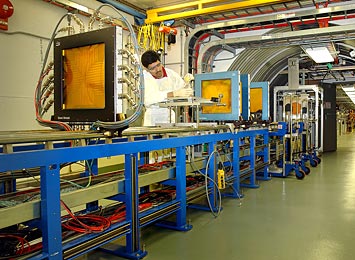 enlarge
enlarge
Scientists at the NASA Space Radiation Laboratory bombard cells, DNA, and electronic equipment with beams that simulate deep space particle radiation to better understand risks and design protective strategies.
The RHIC research program also inspired the U.S. space agency to build and operate its NASA Space Radiation Laboratory (NSRL) at Brookhaven, using beams that come from RHIC's Booster to simulate the kind of particle radiation that permeates deep space. Studies of how these particles affect cells, DNA samples, electronics, and shielding materials are helping scientists evaluate risks and test strategies to protect future astronauts and satellites. Studying the biological effects of radiation in this manner is also offering new insight into our understanding of cancer and the body's defense mechanisms.
Magnets for energy storage
Materials used in accelerator design are also finding new applications. Most of RHIC's magnets, for example, are made of superconductors — remarkable materials that conduct electricity with no energy loss when kept extremely cool. The design of these magnets has made Brookhaven a world-leader in magnet design and the study of superconducting systems, including more recently discovered superconductors that operate at temperatures above a deep chill, which offer enormous promise for future applications.
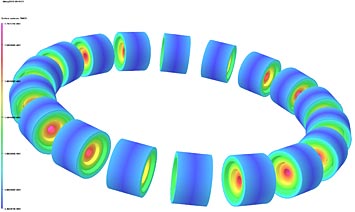 enlarge
enlarge
A superconducting magnet energy storage (SMES) system composed of high-temperature superconducting coils could store large amounts of energy from intermittent sources like solar or wind or provide power off the grid.
Brookhaven scientists are now leading a new frontier in engineering to develop high-temperature superconducting accelerator magnets, as well as superconducting magnets used for storing large amounts of energy. These superconducting magnet energy storage systems (SMES) would enable high-density energy storage — enough to keep the current flowing from a solar- or wind-powered system overnight or when the wind doesn't blow. They could also provide stable electric power off the grid — for example, at military camps deployed in the field — which explains why the Army is helping to fund this research.
Accelerating electrons
Even the future of accelerator science at RHIC — a proposed Electron Ion Collider known as eRHIC — offers promise of applications beyond its role as a tool for investigating the structure of matter. The idea is to add an electron ring to the existing RHIC tunnel so high-speed electrons can probe the inner structure of heavy ions.
"The best way to do this would be to build a novel kind of accelerator known as an energy recovery linac (ERL)," Roser explained. In this type of accelerator, electrons are first accelerated, used, and then decelerated, giving their energy back to the radiofrequency cavities so it can be used to accelerate the next electrons.
"This method maintains the extremely high quality beams that can be obtained from electron sources," Roser said.
An alternate use of such high-quality electron beams would be to pass them through magnet configurations that cause them to emit self-amplifying light, resulting in an enormously powerful laser. Such a laser could fuel further advances in science, including new kinds of x-ray light sources even brighter than the new National Synchrotron Light Source II (see sidebar).
"Throughout Brookhaven's history, we've been on the cutting edge of accelerator science," Roser said. "eRHIC would keep us at the forefront, and keep attracting the physicists most hungry to meet the challenges of 21st Century science — and society."
Research at RHIC is funded primarily by DOE's Office of Science. The Office of Science is the single largest supporter of basic research in the physical sciences in the United States, and is working to address some of the most pressing challenges of our time. For more information, please visit science.energy.gov.
2013-3758 | INT/EXT | Newsroom









